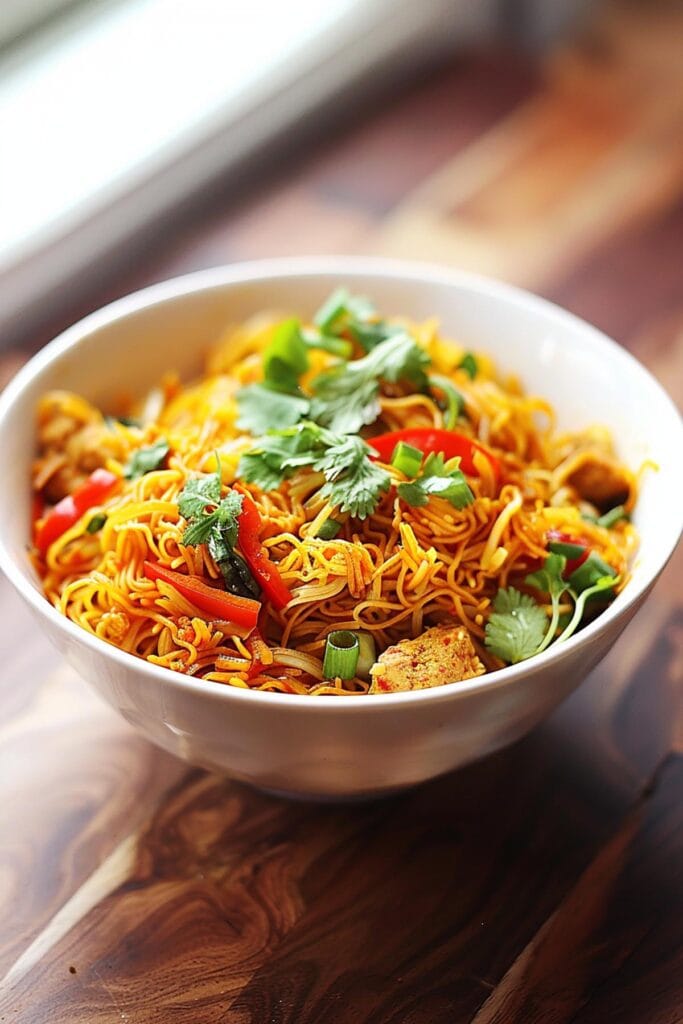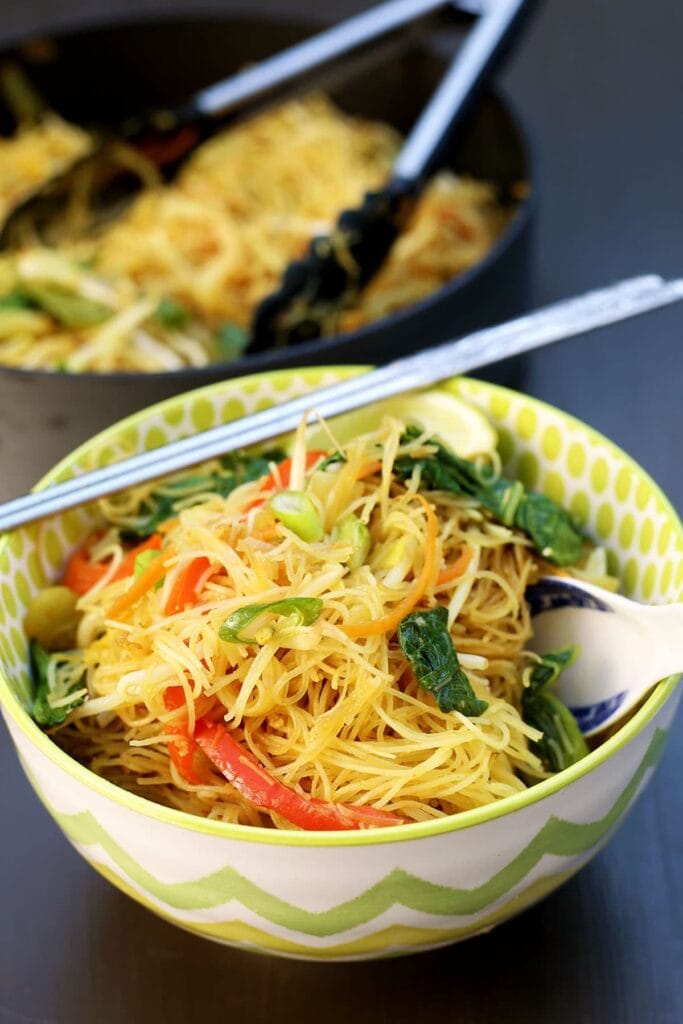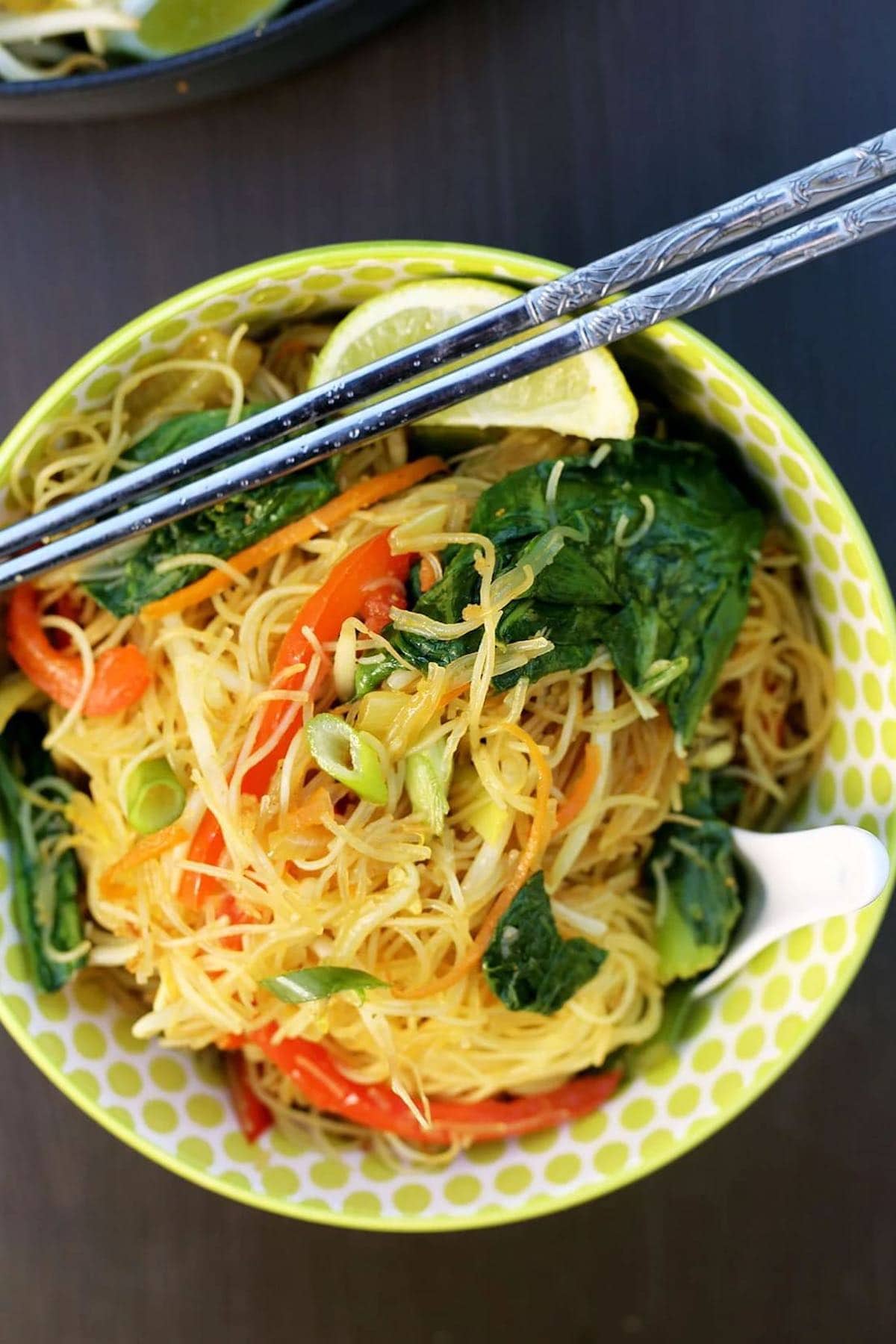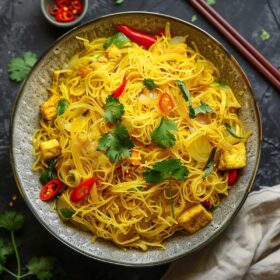My Singapore rice noodle recipe features tender vermicelli noodles stir-fried with crisp veggies and seasoned with curry. It’s quick, easy, and restaurant-worthy!

If you love cooking Asian-inspired recipes, try my soba noodle salad and drunken noodles next!
Quick and easy dinner recipes are our jam, and luckily noodle stir fries tick both of those boxes. When I need a recipe that’s unique yet filled with flavors everyone will love, I make my Singapore noodles.
FREE EBOOK SERIES! 5 SECRETS FOR FOOLPROOF VEGAN DESERTS
You don’t have to head to Hong Kong to experience the amazing flavors of this dish, and it can all be prepared easily at home!
What are Singapore rice noodles?
Contrary to the name, you won’t find Singapore noodles in Singapore. It’s a popular dish in China and is traditionally made with stir-fried veggies, scrambled eggs, shrimp, and Chinese BBQ pork (also known as char siu) and flavored with curry powder.
Why you’ll love this recipe
- Ready in 15 minutes. One of the reasons why Iove stir fries is the minimal prep time and speedy cooking process.
- Budget-friendly. There are no niche or fancy ingredients required–just basic pantry staples and your favorite veggies.
- Unique blend of flavors. I don’t often see Asian flavors mixed with curry spices, but in this dish, it works wonders.
- Great leftovers. This is one of the few noodle dishes I prefer making ahead of time. It reheats great, and the flavors deepen overnight.
Key ingredients
- Vegetable oil. To stir fry.
- Rice vermicelli noodles. I’m able to find these at my mainstream grocery store, though you can also get them online or at an Asian market.
- Vegetables. I used a combination of diced white onion, red bell peppers, snow peas, bok choy, bean sprouts, green onions, and julienned carrots.
- Garlic cloves. For aroma. Freshly minced garlic is preferred, but I’ll use the bottled stuff in a pinch.
For the seasoning:
- Curry powder. The key ingredient! I recommend getting fresh curry powder if possible, as the flavors are more vibrant.
- Vegetable stock. For the ‘broth’ that soaks into the noodles. I’ll also use chicken stock when I have it.
- White pepper & salt. To taste. I prefer the subtle flavor of white pepper, but it can be substituted for black pepper.
- Sweet soy sauce. Adds a fabulous sweet and umami flavor. If you can’t find sweet soy sauce, use regular soy sauce.
- Tamari. Balances out the strong flavors of the soy sauce.
- Brown sugar. Just a pinch to balance the other ingredients. You can also use white sugar or coconut sugar.
- Sesame oil. For sesame flavor.
How to make Singapore noodles
Step 1 – Prep the noodles. Soak the noodles in a small bowl of cold water briefly.
Step 2 – Stir fry. Heat oil in a large nonstick skillet and stir fry the garlic, onion, pepper, peas, carrots, and scallions. Cook until the veggies soften.
Step 3 – Add noodles and spices. Drain the noodles and add them to the wok with the seasonings. Toss the noodles continously and cook until the liquid is absorbed.
Step 4 – Assemble. Add the bean sprouts and bok choy, then turn off the heat. Drizzle with sesame oil right before serving.

Tips to make the best recipe
- Use cold water to soak the noodles. I used warm water the first time, and the noodles became soft and mushy. You want them to keep their shape in the pan, so use cold water.
- Save time. When I’m short on time, I’ll use frozen and thawed veggies.
- Keep the noodles moving. They’re quite fragile and prone to burning, so don’t let them sit in the pan for too long.
- Garnish. Add chopped peanuts, fresh chili, or cilantro for color and flavor.
Variations
- Gluten-free. Traditional vermicelli noodles are made from wheat, so they’re not gluten-free. To make a gluten-free dish, look for dried rice stick noodles, which are similar in texture but made without flour.
- Swap the veggies. The veggies I used are only a suggestion. Feel free to use whatever you have, like cabbage, mushrooms, or water chestnuts.
- Protein. Add cubed and pressed tofu, thin strips of seitan, or tempeh for extra protein.
Storage instructions
To store: Keep the leftovers in airtight containers and store them in the refrigerator for 3-5 days.
To freeze: Place the cooked and cooled noodles in a shallow container and store them in the freezer for up to 2 months.
Reheating: Microwave leftovers in 30-second intervals or warm them in a skillet over medium-high heat until warm.

Frequently asked questions
Rice noodles is a general term that refers to a type of noodle, whereas Singapore noodles are a dish that’s made using thin rice noodles.
Both dishes use different types of noodles. In Singapore noodles, vermicelli rice is used, but for chow mein, the noodles used are made of wheat.
No, these noodles aren’t gluten-free, as they are made of flour. However, you can make this recipe with any gluten-free noodles of your choice.
The base of this dish is rice vermicelli noodles.
More satisfying noodle & pasta dishes
- Healthy vegan japchae noodles
- Vegan mac and cheese
- Miso pasta
- Mushroom pasta
- Or any of these pasta recipes

Singapore Rice Noodles | Easy Authentic Recipe
Ingredients
- 2 tablespoons Vegetable Oil
- 1 large White Onion sliced
- 4 cloves garlic minded
- 1 large bell pepper sliced
- 1 cup peas
- 1 large Carrot julienned
- 2 Green onions sliced
- 1 1/2 cups Bean Sprouts
- 2 Bok Choy
- 8 oz Rice Vermicelli
For the seasoning
- 2 teaspoons Curry Powder
- 1/2 teaspoon White Pepper
- 1 cup Vegetable Stock
- 2 teaspoons Sweet Soy Sauce
- 3 Tablespoons Tamari
- 1/2 teaspoon Brown Sugar
- 1 teaspoon Sesame Oil
Instructions
- Prepare vermicelli noodles by soaking in a large bowl of cold water for 10 minutes.
- In a large wok or saucepan, heat oil up. Gently stir fry garlic, onion, red pepper and snow peas for a minute, then add in carrot and spring onion. Continue stir frying until the veggies soften.
- Drain noodles from water and add into wok. Using tongs, loosen up the noodles so they cook evenly.
- Add all seasoning ingredients to the pan and make sure to keep moving the noodles around so they don’t burn or break up. Stir fry until all the liquid in the wok has been absorbed by the noodles. Taste for seasoning and alter to your preference.
- Add bean sprouts and bok choy into the wok. Toss to heat the veggies through and then turn off the heat. Add sesame oil after the heat has been turned off and stir to mix through.
nina says
spoke says